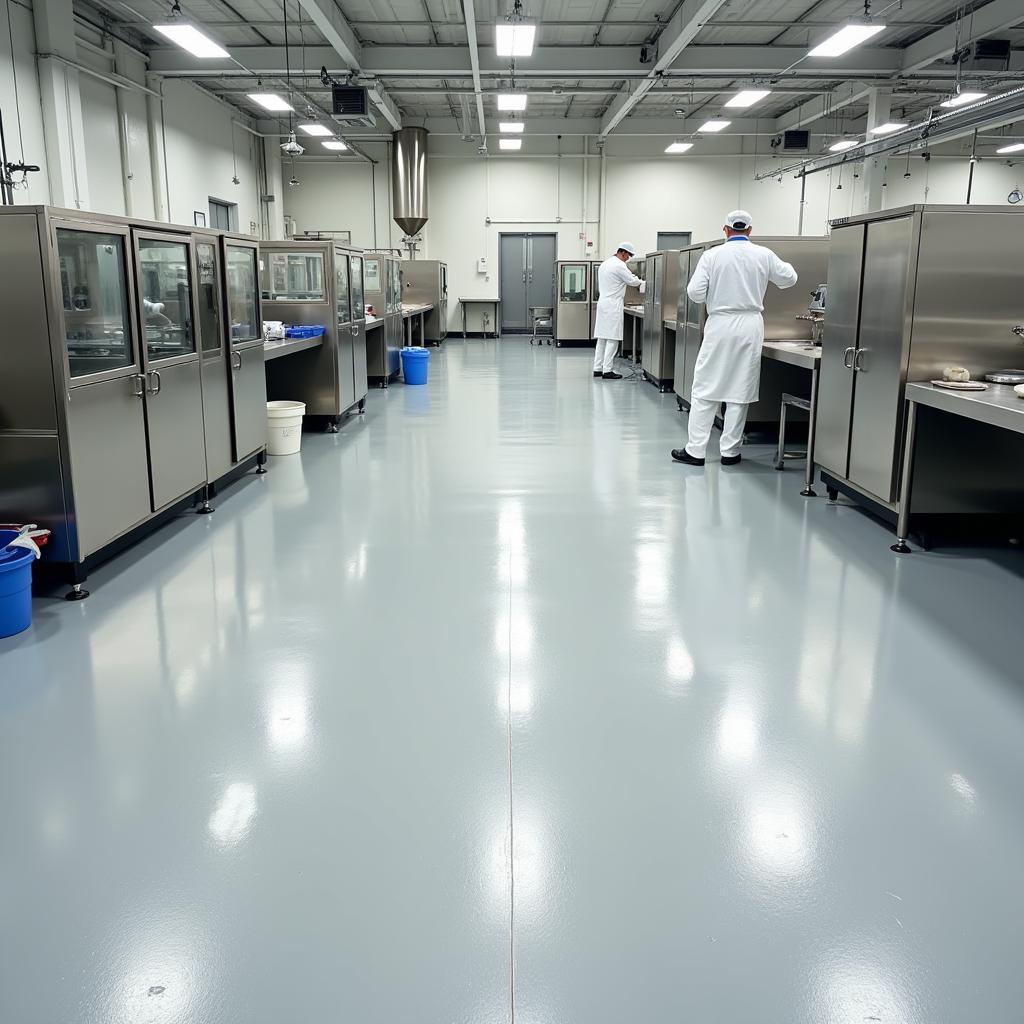Food Safe Flooring is paramount in any environment where food is handled, prepared, or served. Choosing the right flooring isn’t just about aesthetics; it’s a critical investment in maintaining hygiene, ensuring compliance with regulations, and protecting your business. From commercial kitchens to food processing plants, the floor plays a vital role in preventing contamination and ensuring the safety of the food we consume.
Why is Food Safe Flooring So Important?
Food safety is a top priority for consumers and businesses alike. Food safe flooring helps create a hygienic environment by being resistant to spills, bacteria growth, and the accumulation of dirt and debris. This not only protects the quality and safety of the food but also contributes to a cleaner, more professional workspace. Moreover, investing in food grade flooring can significantly reduce the risk of accidents, such as slips and falls, due to its slip-resistant properties.
Key Considerations When Choosing Food Safe Flooring
Selecting the appropriate food safe flooring requires careful consideration of various factors. The environment’s specific needs, the level of foot traffic, and the types of substances the floor will be exposed to all play a role. Additionally, the flooring should be easy to clean and maintain to ensure long-term hygiene and durability.
- Durability: The flooring must withstand heavy foot traffic, equipment movement, and potential impact from dropped objects.
- Slip Resistance: A slip-resistant surface is essential to prevent accidents, especially in areas prone to spills and moisture.
- Cleanability: The flooring should be easy to clean and sanitize to minimize the risk of bacterial growth and contamination.
- Chemical Resistance: Resistance to chemicals, cleaning agents, and food substances is crucial to maintain the flooring’s integrity.
- Temperature Fluctuations: The flooring should be able to withstand temperature variations, particularly in areas with freezers or ovens.
Different Types of Food Safe Flooring
There are various types of food safe flooring available, each with its own advantages and disadvantages. Understanding these differences will help you make an informed decision for your specific needs. Some popular options include epoxy flooring, polyurethane concrete, vinyl flooring, and tiled surfaces.
Epoxy Flooring: A Durable and Seamless Solution
Epoxy flooring is a popular choice for food processing facilities and commercial kitchens due to its exceptional durability and seamless nature. It creates a smooth, impermeable surface that prevents the growth of bacteria and is easy to clean.
“Epoxy flooring is the gold standard for food processing environments,” says John Miller, a food safety consultant with over 20 years of experience. “Its seamless nature and chemical resistance make it ideal for maintaining a hygienic and safe workspace.”
 Epoxy Flooring in a Food Processing Plant
Epoxy Flooring in a Food Processing Plant
Polyurethane Concrete: A Resilient and Versatile Option
Polyurethane concrete offers a combination of resilience and versatility, making it suitable for a wide range of food service environments. It’s resistant to thermal shock, impact, and abrasion, while also providing good slip resistance. Thinking about a food truck floor? Polyurethane concrete might be the right choice for you.
Vinyl Flooring: A Cost-Effective and Easy-to-Install Choice
Vinyl flooring is a cost-effective and easy-to-install option for areas with less demanding requirements. It’s available in various colors and patterns, providing flexibility in design. However, its durability may be lower compared to epoxy or polyurethane concrete. Wondering about materials? Learn more about whether is pvc food grade.
Maintaining Your Food Safe Flooring
Proper maintenance is crucial to ensure the longevity and effectiveness of your food safe flooring. Regular cleaning, prompt spill cleanup, and the use of appropriate cleaning agents are essential to prevent damage and maintain hygiene. For a comprehensive guide to setting up a successful food business, consider reviewing a detailed food processing floor plan. If you’re outfitting a food truck, you’ll find a well-planned layout essential, similar to choosing the right pizza food truck equipment.
Conclusion
Investing in food safe flooring is a crucial step in ensuring a hygienic and safe food environment. By carefully considering the different options and implementing proper maintenance procedures, you can protect your business, your employees, and your customers. Choosing the right food safe flooring is not just a good practice; it’s an investment in the long-term success and reputation of your business.
FAQ
- What is the best type of food safe flooring?
- How much does food safe flooring cost?
- How do I clean food safe flooring?
- What is the lifespan of food safe flooring?
- Can I install food safe flooring myself?
- What are the regulations regarding food safe flooring?
- How do I choose the right slip resistance for my food safe flooring?
Need support? Contact us at Phone Number: 02437655121, Email: minacones@gmail.com Or visit us at: 3PGH+8R9, ĐT70A, thôn Trung, Bắc Từ Liêm, Hà Nội, Việt Nam. We have a 24/7 customer service team.